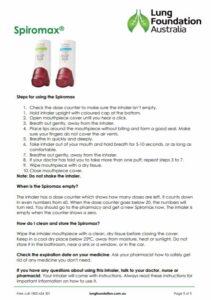The Spiromax® Inhaler Device Technique Factsheet from Lung Foundation Australia provides essential guidance to help people with COPD or asthma use their Spiromax® inhaler correctly. The Spiromax is a breath-activated dry powder inhaler that delivers medication directly to the lungs, but correct technique is essential to ensure the full dose is received. Many people are unaware that incorrect inhaler use can lead to poor symptom control, increased breathlessness, and a higher risk of exacerbations. This factsheet provides step-by-step instructions to help users improve their inhaler technique and get the most from their treatment.
The resource outlines the correct method for using a Spiromax® inhaler, starting with opening the device by fully flipping the mouthpiece cover down until it clicks. Users are instructed to breathe out gently away from the inhaler before placing the mouthpiece between their lips and taking a strong, deep breath in to activate the dose release. Unlike press-and-breathe inhalers, the Spiromax® does not require pressing a button or coordinating inhalation with actuation, making it easier for many users. The factsheet also highlights the importance of holding the breath for a few seconds after inhalation to allow the medication to be fully absorbed in the lungs. After use, the mouthpiece cover should be closed to protect the inhaler from dust and moisture.
The factsheet also addresses common mistakes that can reduce the effectiveness of the medication, such as failing to fully open the mouthpiece cover before inhalation, breathing in too weakly to activate the dose, or exhaling into the inhaler, which can affect the medication. The guide helps users recognise and correct these errors to improve medication delivery. People using a Spiromax® inhaler can apply this information by following the correct steps every time they take their medication, checking their technique with a healthcare professional, and keeping the factsheet as a reference to reinforce good inhaler habits.
Ensuring proper inhaler technique is an important part of managing COPD and asthma effectively. Download the factsheet today and take a moment to check your technique—if you’re unsure, ask your doctor, nurse, or pharmacist for a quick review to make sure you’re receiving the full benefit of your medication.
Was this page helpful?
Good job! Please give your positive feedback
How could we improve this post? Please Help us.
